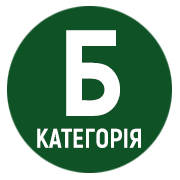THE ISSUE OF NEO-NAZISM IN THE COLUMNS OF WORLD SCIENTIFIC JOURNALS
Abstract
The publication presents the study of modern neo-Nazi ideology in the countries of Central and Eastern Europe. Right-wing radical movements and certain extremist groups whose ideology is built on the foundations of National Socialism are called neo-Nazis. Significant involvement of the scientific community of journalists, historians, political scientists and sociologists in the issue of neo-Nazism was revealed. The topic of neo-Nazism presented by European and American researchers is outlined. In particular, the authors provide a detailed overview of the neo-Nazi movement in Austria, Germany, Poland, Romania, Hungary, Croatia, etc. In addition, the main milestones of the cooperation of media representatives with neo-Nazis are outlined and their creation of a popularizing factor of ideology in a certain society is analyzed. A historical overview was provided regarding the formation of the main postulates of the creation and development of the neo-Nazi movement, in particular, after the Second World War and the collapse of the Soviet Union. However, it is determined that the topic of neo-Nazism in Western Europe is better researched than in the countries of Central and Eastern Europe. Researchers in the latter focused mainly on the creation of radical political parties and did not conduct empirical research on the activities of extremist groups. The author analyzed individual publications in which considerable attention was paid to the beginnings of the creation of neo-Nazi ideology. Scientific investigations revealed a number of factors that contributed greatly to the development of ideology in certain countries. It was found that the conditions of globalization challenges, which provoke economic, political, and security crises, become a favorable platform for the formation of neo-Nazi propaganda. The practical significance of the research results: the developed material can be used for the formation of educational programs on international journalism and media literacy in higher educational institutions.
References
2. Antisemitism: Overview of data available in European Union 2008-2018. URL: https://fra. europa.eu/sites/default/files/fra_uploads/fra-antisemitism- overview-2008-2018_en.pdf
3. Buchholz K. Where have far-right parties had most success in Europe? // Statista, 2022. URL: https://www.statista.com/chart/20094/national-election- success-of-far-right-parties-europe/
4. Colborne M. Neo-Nazi from across Europe rally in Budapest. URL: https://www.aljazeera.com/ news/2020/2/8/neo-nazis-from-across-europe-rallyin- budapest
5. Counteraction to manifestations of neo-Nazism and right-wing extremism. Parliamentary Assembly of the Council of Europe, Counteraction to manifestations of neo-Nazism. URL: https://assembly.coe.int/nw/xml/ XRef/Xref-XML2HTML-en.asp?fileid=21219&lang=en
6. Eatwell R. How to revise history (and influence people?), Neo-Fascist style // The far-right in Western and Eastern Europe / ed. Luciano Cheles. London : Longman, 1995. P. 309.
7. European populism: trends, threats and future prospects / Tony Blair Institute for Global Change URL: https://www.institute.global/insights/geopolitics- and-security/european-populism-trends-threatsand- future-prospects
8. Gattinara C. Discourses and practices of violence in the Italian extreme right: Frames, symbols and identity- building in CasaPound Italia // International Journal of Conflict and Violence. 2014. № 1. 154–170 pp.
9. Hockenos P. Free to hate: The rise of the right in post-communist Europe. London : Routledge, 1993. P. 12.
10. Jarausch K. The conundrum of complicity in The law in Nazi Germany: ideology, opportunism, and the perversion of justice / ed. Alan E. Steinweis and Robert D. Rachlin. New York : Berghahn, 2015. P. 3.
11. Lee J. Nazism and Neo-Nazism in Film and Media. Amsterdam : Amsterdam University Press, 2018. 263 p.
12. Minkenberg M. The Renewal of the Radical Right: Between Modernity and Anti‐modernity // Government and Opposition. 2000. № 35. Pp. 170–188.
13. Minkenberg M. The rise of the radical right in Eastern Europe: Between mainstreaming and radicalization // Georgetown Journal of International Affairs. 2017. № 18. Pp. 29–31.
14. Ramalingam V. Old threat, new approach: Tackling the far-right across Europe. London: Institute for Strategic Dialogue, 2014. 46 p.
15. Rydgren J. Is Extreme Right-Wing Populism Contagious? Explaining the Emergence of a New Party Family // European Journal of Political Research, 2005. 413–437 pp.
16. Skinhead International: A Worldwide Survey of Neo-Nazi Skinheads. URL: https://www.ojp.gov/ ncjrs/virtual-library/abstracts/skinhead-internationalworldwide- survey-neo-nazi-skinheads
17. Smith A. The dark side of nationalism: the revival of nationalism in the late twentieth century Europe in The far-right in Western and Eastern Europe / ed. Luciano Cheles. London: Longman, 1995. P. 13
18. Tismaneanu V. Is East-Central Europe backsliding? Leninist legacies, pluralist dilemmas // Journal of Democracy. 2007. № 4. P. 34–39.
19. Stowarzeszenia «Nigdy więcej». URL: https://www.nigdywiecej.org/
20. Żuk P. Non-alternative reality? On the misery of the Left in Eastern Europe: the case of Poland // Journal of Contemporary Central and Eastern Europe. 2017. № 1. pp. 63–66.



